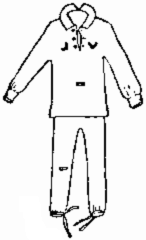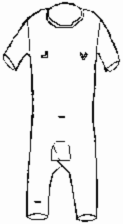Articles Necessary for Temple Initiatory Work (Washings and Anointings)
Special regalia (ritual clothing) is needed for temple work. In order
to participate in the Initiatory Work one needs a Shield and a
Garment.
The Shield is a poncho-like covering. It is made by folding a rectangular
piece fabric (such as terry cloth, or cotton flannel) in half, and cutting
a circular opening at the fold for the patrons head to fit through. It
reaches about eight inches from the floor on both sides, and covers the
front and back sides. The sides are open, and are held closed by the patron.
Prior to receiving the Washings and Anointings the patron removes all
clothing and puts on the shield in the privacy of a locker. The temple
worker performing the Washings and Anointings touches the partron's various
body parts as they are mentioned in special blessing s/he recites. It
must be understood that all Washings and Anointings are performed in sexually
segregated rooms.
The Garment of Holy Priesthood (Garment, Regulation Garment, Temple Garment) is distinguished as the only article of Temple clothing members are expected to wear outside the Temple confines. It represents the garment given to Adam when he was found naked in the garden of Eden. It is an undergarment with religious significance and has four symbols known as the "Marks of the Holy Priesthood" sewn into it. Over the left breast is "the mark of the compass"; over the right breast is "the mark of the square"; over the navel is a mark, and another appears over the right knee (the latter two are one-inch horizontal lines). These marks remind the wearer of the covenants assumed in the temple ritual. There are currently a variety of Church-approved Garment styles available for wear (manufactured by the LDS-owned Beehive Clothing Mills). Garments are currently available in one-piece (ankle-length, long sleeve; ankle-length, short sleeve; button front; knee-length, short sleeve) and two-piece styles, some of which are available in square back, V-back, crew neck, maternity and nursing varieties. They may be made of cotton, polyester, nylon, nylon-mesh, rayon and/or rayon-nylon (Bemberg) fabrics. Early Garments were reportedly made of unbleached muslin and/or cotton.
The Nauvoo "old style" Garment (c1842-1975) was partially described by Ebenezer Robinson (who had once served as the editor of the Mormon newspaper Times and Seasons) in his periodical The Return Vol. II (April 1890), 252:
"As early as 1843 a secret order was established in Nauvoo, called the HOLY ORDER, the members of which were of both sexes, in which, we are credibly informed, scenes were enacted representing the garden of Eden, and that the members of the order were provided with a peculiar under garment called a robe. 'It was made in one piece. On the right breast is a square, on the left a compass, in the center a small hole, and on the knee a large hole.' This was the description of the garment as given to the writer in Nauvoo, in Joseph Smith's life time. It was claimed that while they wore this 'robe' no harm could befall them."
Increase McGee Van Dusen, who described the Nauvoo temple endowment ceremony in 1847, mentioned that the Garment was a "tight fit" and only remembered the Priesthood marks of the square and compass-mistakenly stating the latter was on the knee. A description attributed to Elizabeth Warren Allred, who had been hired by the Prophet Joseph Smith to cut out the garment pattern, intimated that the Marks of the Holy Priesthood were originally stitched in red:
"It was while they were living in Nauvoo that the Prophet came to my mother, who was a seamstress by trade, and told her that he had seen the Angel Moroni with the garments on, and asked her to assist in cutting out the garments. They spread unbleached muslin out on the table and he told her how to cut it out. She had to cut the third pair, however, before he said it was satisfactory. She told the prophet that there would be sufficient cloth from the knee to the ankle to make a pair of sleeves, but he told her he wanted as few seams as possible and that there would be sufficient whole cloth to cut the sleeve without piecing. The first garments were made of unbleached muslin and bound with turkey red and were without collars. Later on the prophet decided he would rather have them bound with white. Sister Emma Smith, the Prophet's wife, proposed that they have a collar on as she thought they would look more finished, but at first the prophet did not have the collars on them. After Emma Smith had made the little collars which were not visible from the outside of the dress, Sister Eliza R. Snow made a collar of fine white material which was worn on the outside of the dress. The garment was to reach to the ankle and the sleeves to the wrist. The marks were always the same." (Diary of James T.S. Allred; Letter to Col. Williams; [Microfilm d.1021/f.92, end of roll #2 (July 10, 1844)] LDS Church Archives, Salt Lake City).
The design of the garment has gone through various stages of evolution, the four principle designs are illustrated below. The earliest Nauvoo-period garment (c1842) is based on an original owned by Hyrum Smith, Joseph Smith's brother.
The Evolution of the Temple Garment
 |
 |
 |
 |
|
ca. 1842
|
ca. 1842-1975
|
1923 - present
|
1979 - present
|
The second garment shown above was commonly called the "old style" temple
garment. It was used in Initiatory Ordanances until 1975, at which time
patrons receiving their own endowment were clothed in the third style
shown. This third garment is put on by stretching the neck open wide and
stepping into it one leg at a time. In 1979 the new two-piece garment
was introduced, which became very popular with missionaries and sports-active
Mormons.
Below appears a list of the temple clothes. It should be noted that at
certain stages of the endowment, participants are required to change their
robes and caps from the left side of the body to the right side (the girdles
are worn opposite the robe). This indicates a transition from officiating
in the ordinances of the lower, or Aaronic Priesthood, to the higher,
or Melchizedek Priesthood.
Articles Necessary for Temple Endowment Work
This includes articles worn by couple at time of marriage.
For men:
White Robe (worn over the shoulder)
White Cap (has a bow on one side, and a string on the other side. It
is tied to one of three loops on the top of the robe)
White girdle (worn as a sash, and tied over the hip on the opposite
side as the robe)
Green apron (with fig-leaf pattern)
White Trousers and Shirt (or White Jumper)
White Tie (optional)
White socks
White slippers or moccasins of sturdy fabric.
For women:
White Robe (worn over the shoulder)
White Veil
White girdle (worn as a sash, and tied over the hip)
Green apron (with fig-leaf pattern)
White Dress
White slip
White hose
White slippers or moccasins of sturdy fabric.
Below is a picture of the temple clothing from an old exposure of the
endowment called "Lifting the Vail." It was published in The Daily
Tribune (Salt Lake City, Utah), Sunday September 28, 1879. It shows
the "old style" garment, a robe, a cap, an apron and a woman's veil (the
head is placed in the hole, the diamond-shaped part hangs down the back,
and the two strings are tied beneath the chin).

This page Copyright (c) 1996 by Vince Hoffer.
This page was last modified on May 20, 1997.